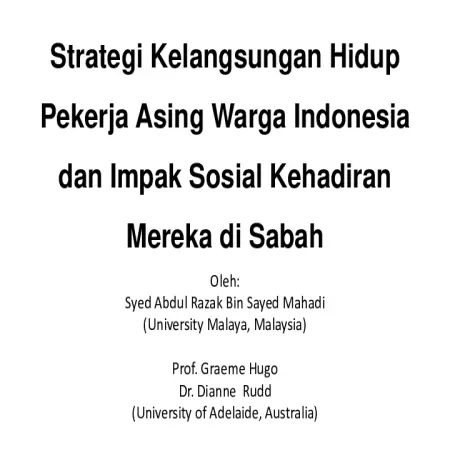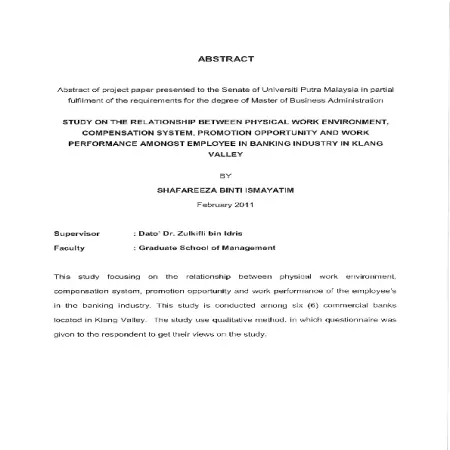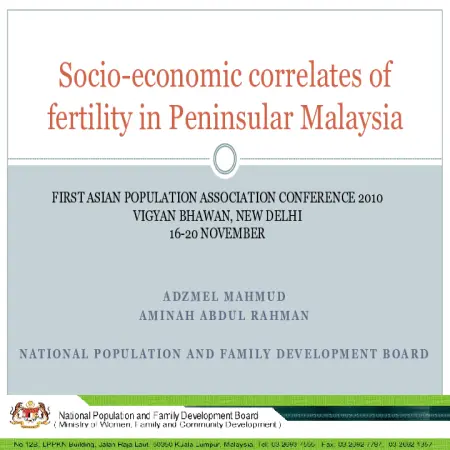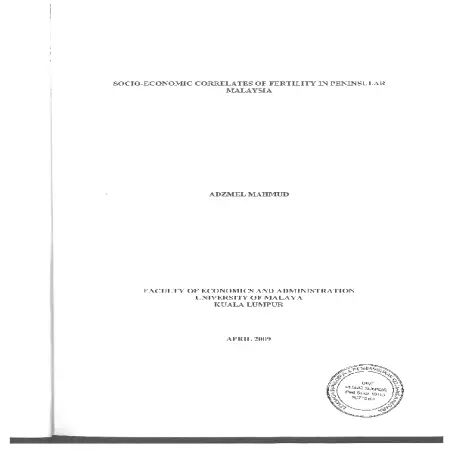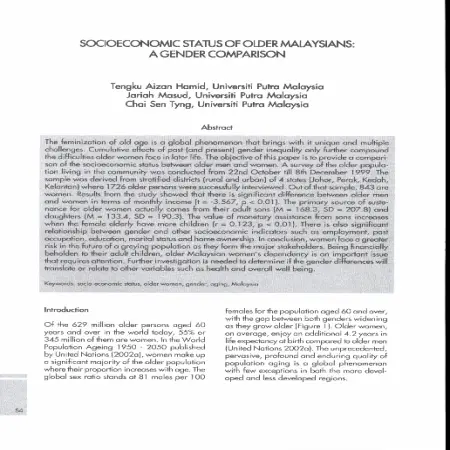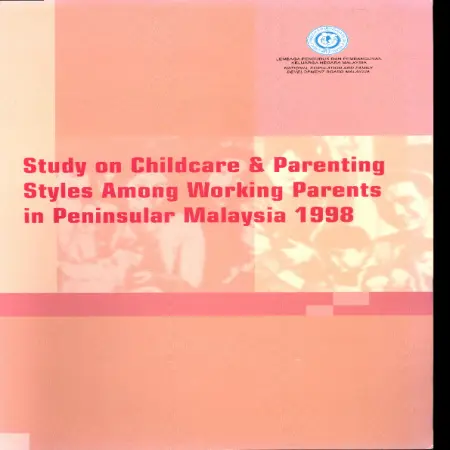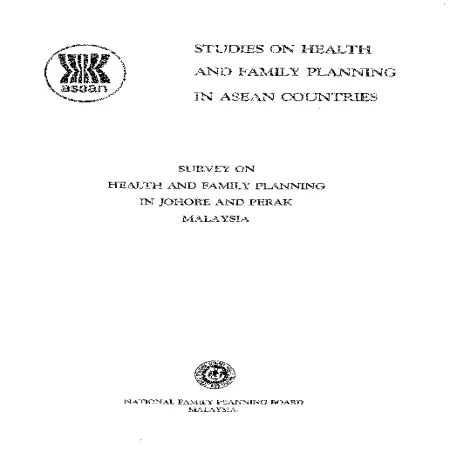Browse by Year
|
|
Strategi kelangsungan hidup pekerja asing warga Indonesia dan implikasi sosial akibat kehadiran mereka di Sabah
Item Type: Conference or Workshop Item
Editor:
Year: 00/00/2012
Abstract: Sabah's direction focuses on the development of 3 main sectors such as agriculture, tourism and manufacturing to drive the economy. As an agro -economy -based state, the 2010 census recorded 30 per cent of the total workforce engaged in the agricultural sector. As locals are not interested in seizing employment opportunities in the 3D -based agriculture and plantation sector (Difficult, Dirty & Dangerous), job vacancies are filled mainly by Indonesian workers as shown in data obtained from Temporary Work Visit Passes (TWVP). Certainly, their presence has social implications for the state of Sabah which housed 27.7 percent of the foreign population in 2010. Therefore, a micro study needs to be conducted to understand and analyze this situation. A joint study was conducted with NPFDB, in which a total of 896 respondents consisting of Indonesian workers from the plantation, manufacturing, construction, services and informal sectors were interviewed in a survey in the Tawau Division in 2010. In addition, primary data were also collected from interviews. Conducted among legal and illegal employees as well as based on the researcher’s observations. Interviews with government officials directly involved with the management and recruitment of foreign workers were also conducted. Secondary data were obtained from various government agencies in Sabah such as the Immigration Department, Manpower Department, Statistics Department, Health Department and Education Department. This study successfully identified 5 survival strategies that are often used by Indonesian workers to ensure the success of their migration, namely family networking, choice of residence, cultural adaptation and assimilation, economic survival and involvement in social and political institutions. Of course, the implementation of this strategy has a social impact on the local people. Important findings of this study show that most Indonesian workers come to Sabah with family members. Certainly the presence of spouses and children has huge implications for social facilities especially health and education. Therefore, there must be integration between the entry of foreign workers with Sabah's development planning, especially if the dependence on foreign labor continues until Sabah achieves the status of a technology - intensive economy in the future.
|
|
|
|
|
|
Study on the relationship between physical work environment, compensation system, promotion opportunity and work performance amongst employee in banking industry in Klang Valley
Item Type: Thesis
Editor:
Year: 01/02/2011
Abstract: This study focusing on the relationship between physical work environment, compensation system, promotion opportunity and work performance of the employee's in the banking industry. This study is conducted among six (6) commercial banks located in Klang Valley. The study use qualitative method, in which questionnaire was given to the respondent to get their views on the study. As for this study, the six selected banks and employees were chosen using the simple random sampling method. A total of 150 questionnaires were distributed to the employees and 120 questionnaires were returned and usable for further analysis. This study used Statistical Package for Social Science (SPSS) version 18.0 to analyze the data. The study found that physical working environment, compensation system and promotion opportunity have a positive relationship with the employee's work performance. All of the elements had only a low level significance relationship with work performance. However, from the three elements, promotion opportunity was the highest significance level of relationship, followed by the physical work environment and lastly the compensation system. This means that employee's work performance thus not much affected by the physical work environment, compensation system and promotion opportunity that organization have provided or introduced.
|
|
|
|
|
|
Socio-economic correlates of fertility in Peninsular Malaysia
Item Type: Conference or Workshop Item
Editor:
Year: 00/00/2010
Abstract: To examine fertility trends and differentials among women in Peninsular Malaysia by selected socioeconomic variables which significantly influence the number of children ever born. A total of 3,697 ever-married women aged 15-49 were successfully interviewed in Peninsular Malaysia.
|
|
|
|
|
|
Socio-economic correlates of fertility in Peninsular Malaysia
Item Type: Thesis
Editor:
Year: 01/04/2009
Abstract: The main aim of this paper is to examine the fertility trends and differentials among Peninsular Malaysia women based on the 2004 Malaysian Population and Family Survey (MPFS-4) according to selected socio-economic variables which were found to have significant effect on number of children ever born. Findings from the study reveal that mean number of children ever born has dropped from 4.2 children in 1974 to 3.6 children in 1984, 3.4 children in 1994 and continued to decline to 3.1 in 2004. Fertility level is highest among Malays, who resides in rural areas, eastern region, lower educational level, women who had never worked, women whose husbands worked in agricultural sector and family income less than RM1000 a month. Socio-economic variables can only affect the fertility level through the intermediate variables such as postponement of marriage and use of contraception. There is an upward trend in age at first marriage from 17.6 years in 1974 to 22.0 years in 2004. Marriage postponement is more pronounced among highly educated Chinese women, followed by the Indians and the Malays. The contraceptive prevalence rate was highest among Chinese, followed by the Indians and the Malays. Ethnic differentials in number of children ever born are rather pronounced. In the multivariate context, after adjusting for age and age at first marriage, the differential in the mean number of children ever born among ethnic groups remain discernible. The socio¬economic variables have different effects on the fertility level of each ethnic group. 'Region' emerges as the most important predictor of Malay fertility, while 'work pattern' and 'family income' is the most important predictor of Chinese and Indian fertility respectively. Based on the present trend, it is highly likely that the fertility will reach replacement level by 2020, and the 70 million population target is unlikely to be achieved through natural increase. There is a need for the government to give some attention to the trend in delayed and non-marriage as this will determine to a large extent the future course of population growth in Malaysia.
|
|
|
|
|
|
SMARTSTART module
Item Type: Module
Editor:
Year: 00/00/2006
Abstract: Couples planning to get married must be well prepared in order to create a harmonious marriage. Hence, the National Population and Family Development Board organises the SMARTSTART Premarital Programme for couples who are planning to get married and those who have recently married (not more than five years) in four languages, i.e. Malay, English, Mandarin and Tamil.
This module has been developed to provide newly married couples and those who are planning to get married with knowledge and skills on the various aspects of marriage and parenting so as to support them psychologically and prepare them for a harmonious marriage life.
|
|
|
|
|
|
Socioeconomic status of older Malaysians: a gender comparison
Item Type: Article
Editor:
Year: 00/01/2004
Abstract: The feminization of old age is a global phenomenon that brings with it unique and multiple challenges. Cumulative effects of past (and present) gender inequality only further compound the difficulties older women face in later life.The objective of this paper is to provide a comparison of the socioeconomic status between older men and women. A survey of the older population living in the community was conducted from 22nd October till 8th December 1999.The sample was derived from stratified district (rural and urban) of 4 states (Johor, Perak, Kedah, Kelantan) where 1726 older persons were successfully interviewed. Out of that sample, 843 are women. Results from the study showed that there is significant difference between older men and women in terms of monthly income(t=-3.567,p<0.01). The primary source of sustenance for older women actually comes from their adults sons (M=168.3, SD=207.8)and daughters (M=133.4,SD=190.3). The value of monetary assistance from sons increases when the female elderly have more children (r=0.123,p<0.01). There is also significant relationship between gender and other socioeconomic indicators such as employment, past occupation, education, marital status and home ownership. In conclusion, women face a greater risk in the future of a greying population as they form the major stakeholders. Being financially beholden to their adult children, older Malaysian women's dependency is an important issue that requires attention. Further investigation is needed to determine if the gender differences will translate or relate to other variables such as health and overall well being.
|
|
|
|
|
|
Study on childcare & parenting styles among working parents in Peninsular Malaysia 1998
Item Type: Research Report
Editor:
Year: 00/00/1998
Abstract: The Study on Childcare and Parenting Styles among working Parents in Malaysia is one of the three research issues on the family that has been identified by the Ministry of National Unity and Social Development under the "Pelan Induk Tindakan Sosial (PINTAS)". This survey is timely in view of the many challenges faced by Malaysian families who have been affected directly or indirectly by modernisation, urbanisation and industrialisation as a result of socio-economic development. Female labour force participation has increased from 37 per cent in 1970 to 42 per cent in 1991 and is expected to reach 52 per cent by year 2000. The objectives of the study were: • To study the current situation in childcare arrangements among working parents and to elicit suggestions from them regarding improvements in childcare. • To study parenting styles among working parents and to make recommendations for better parenting practices. • To use findings from the study as an input towards designing strategies and programs for the betterment of families. • To obtain indicators on childcare and parenting for the monitoring of goals and targets in the National Plan of Action on Children.
|
|
|
|
|
|
Survey on health and family planning in Johore and Perak Malaysia
Item Type: Research Report
Editor:
Year: 00/00/1982
Abstract: The Malaysian project on Studies on Health and Family Planning aims to make a comprehensive analysis of the state of the health care and family planning service and delivery systems in Malaysia to enable health and population planners and administrators in more effective planning and programme management. This study will include traditional medicine in relation to health and family planning.
|
|
|
|
|
|
Study on childcare needs of low income women in urban Malaysia
Item Type: Research Report
Editor:
Year: 00/09/1979
Abstract: The project "Child care needs of low income women" focused on the needs of families of each ethnic group in urban Kuala Lumpur. Nearly 500 couples, both husbands and wives, were interviewed to determine the differing problems faced by working and nonworking women in their effort to care for their children and provide for their basic needs. Low income families in selected squatter areas and low-cost flat complexes in Kuala Lumpur.
|
|
|
|
|
|
Study on migration: study of four major cities in Peninsular Malaysia
Item Type: Research Report
Editor:
Year: 00/00/1979
Abstract: This study aims at providing some information about the origin of the migrants in terms of place of birth and previous residence and reason for making the moves. The problem of excessive population growth rate in the metropolitan areas of less developed countries has been a major area of concern. In Peninsular Malaysia, the average annual population growth rate in urban areas during the 1970-1980 period was 4.7 per cent while in the rural areas it was only 0.9 per cent. This difference was due not only to differences in rates of natural increase but mainly because of internal migration. Such trends in migration will have significant demographic and socio-economic effects on both the rural and urban areas. Studies on internal migration in Malaysia have focus primarily on the analysis of levels and trends, using data available from population census. Information obtained from such data are rather limited and thus sample surveys have been conducted to gather detailed information regarding reasons for migration, migrants characteristics, migration related decision-making process and post-migration adaptation.
|
|
|
|





